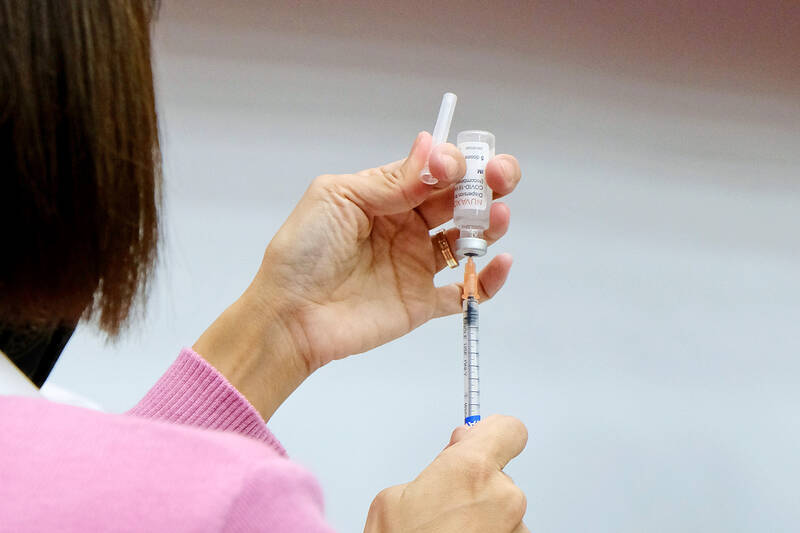Taiwan’s Centers for Disease Control (CDC) on Wednesday announced a plan to buy 5.5 million doses of COVID-19 vaccines targeting new variants that it will begin administering, along with flu vaccines, in October.
Due to the COVID-19 virus continuing to mutate, the CDC will purchase vaccines that offer better protection against new strains, CDC spokesperson Tseng Shu-hui (曾 淑慧) said.
Tseng added that the agency plans to purchase 5.5 million doses within the year, but did not specify which variant the new jab would target.

Photo: CNA
The administration of the new vaccine will be scheduled in two phases and happen at the same time as the flu vaccine.
The first phase will kick off on Oct. 1 and individuals aged 65 and over, healthcare workers, and pregnant women will be eligible for both shots, Tseng said,
The second phase will begin on Nov. 1 and all individuals six months and older will be eligible for a COVID-19 vaccine. Those between 50-64 will also be encouraged to have a flu jab.
The CDC did not explain how enough COVID-19 vaccines would be sourced to inoculate all those eligible. The total resident population in Taiwan is 23,413,608 as of May 2024.
On June 13, the U.S. Food and Drug Administration updated its recommendations regarding COVID-19 vaccines, urging manufacturers, where feasible, to update vaccines so they target the KP.2 variant in 2024 and 2025.
Huang Li-min (黃立民), a specialist in pediatric infectious disease at National Taiwan University Hospital, said that since vaccine manufacturers have not yet produced vaccines targeting the KP.2 variant, it is likely that only vaccines targeting the JN.1 variant will be available this fall and winter in Taiwan.
He also noted that the CDC would likely purchase Moderna shots because updating Novovax COVID-19 vaccines has proven trickier due to technical constraints.
For individuals unable to receive mRNA vaccines, Huang said the existing XBB vaccine is still effective at preventing severe illness.
He added that even if JN.1 or KP.2 variants of COVID- 19 vaccines are unavailable, Novavax’s XBB vaccine could still be a viable alternative.
According to the data released by the CDC on Tuesday, Taiwan has seen a continuous rise in COVID-19 cases for five consecutive weeks, with 817 new local cases reported from June 18 to 24.
Over the past four weeks, the JN.1 variant has been the most prevalent strain in Taiwan, accounting for 62 percent of domestic cases and 47 percent of imported cases.
Meanwhile, the KP.2 variant has made up 18 percent of domestic cases and 25 percent of imported cases.
Tseng said that the authorities only need to be informed of a COVID-19 case if it is moderate or severe.
She predicted that the epidemic would continue to spread slowly until mid-July and that the rate of increase in cases in the upcoming two weeks was expected to be lower than in the previous two weeks.

A strong continental cold air mass is to bring pollutants to Taiwan from tomorrow, the Ministry of Environment said today, as it issued an “orange” air quality alert for most of the country. All of Taiwan except for Hualien and Taitung counties is to be under an “orange” air quality alert tomorrow, indicating air quality that is unhealthy for sensitive groups. In China, areas from Shandong to Shanghai have been enveloped in haze since Saturday, the ministry said in a news release. Yesterday, hourly concentrations of PM2.5 in these areas ranged from 65 to 160 micrograms per cubic meter (mg/m³), and pollutants were

Taiwan’s armed forces have established response protocols for a wide range of sudden contingencies, including the “Wan Chun Plan” to protect the head of state, the Ministry of Defense (MND) said today. After US President Donald Trump on Saturday launched a series of airstrikes in Venezuela and kidnapped Venezuelan President Nicolas Maduro, concerns have been raised as to whether China would launch a similar “decapitation strike” on Taiwan. The armed forces regularly coordinate with relevant agencies and practice drills to ensure preparedness for a wide range of scenarios, Vice Minister of National Defense Hsu Szu-chien (徐斯儉) told reporters before a

EVA Airways on Saturday said that it had suspended a pilot and opened an investigation after he allegedly lost his temper and punched the first officer several times as their plane was taxiing before takeoff at Los Angeles International Airport. According to a report published on Thursday by The Reporter, the incident occurred after the flight’s Malaysian first officer tried to warn the Taiwanese pilot, surnamed Wen (文), that he was taxiing faster than the speed limit of 30 knots (55.6kph). After alerting the pilot several times without response, the first officer manually applied the brakes in accordance with standard operating

NOT AN OPENING: Trump’s violation of international law does not affect China’s consideration in attacking Taiwan; Beijing lacks capability, not precedent, an official said Taiwanese officials see the US’ capture of the president of Venezuela as a powerful deterrent to Beijing’s aggression and a timely reminder of the US’ ability to defeat militaries equipped with Chinese-made weapons. The strikes that toppled Venezuelan President Nicolas Maduro signaled to authoritarian leaders, including Chinese President Xi Jinping (習近平), US President Donald Trump’s willingness to use military might for international affairs core to US interests, one senior official in Taipei’s security circle said. That reassured Taiwan, the person said. Taipei has also dismissed the idea that Trump’s apparent violation of international law could embolden Beijing, said the official, who was not